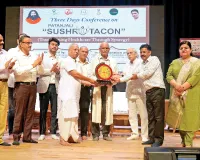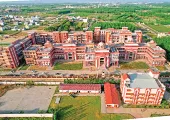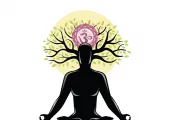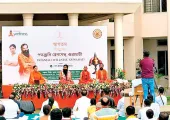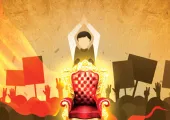Rise of Nation-State in Europe
On

Pro. Kusumlata Kedia
Generally, most of the educated people in India are also ignorant about the facts of the rise of the nation state in Europe. There are many people who think that like India, most of the European states have been nation-states since time immemorial. That's why it is most important to know the facts in this subject. In fact, the rise of the nation-state in Europe is a very recent phenomenon. The idea of the present form of the state itself came to the fore for the first time in the 19th century AD. The scholars of Europe have their own statement that in the context of the development of industrialization and capitalism, the state came to be thought of as an important institution. Some of the intelligentsia, who played a major role in the growth of industrialization and capitalism, began to consider the formation of a modern state as necessary for the protection of both.
Europe has been an agricultural rural society
It is necessary to know some general facts about the then background here. In the late 19th century, even in the beginning of the 20th century AD, 95 to 98 percent of Europe's population was rural and thus almost the whole of Europe mainly a rural society. This also needs to be understood in a special way, because no village has ever existed in Europe in the sense in which villages are understood in India and other densely populated Asian countries. There must have been some so-called cities of theirs, which were of the same size as the big villages of India. The population of any city at that time was only in a few thousands. Similarly, Europe was mainly an agricultural society till the beginning of the 20th century AD. This also needs to be known specially, because the meaning taken from agricultural society in India and other Asian countries, no such society and no such farming ever existed in Europe till the beginning of 20th century AD. When India is said to be an agrarian society, then it is believed that a society in which the main components of nutrition and prosperity will come from agriculture.
No European state is able to feed itself
The situation is not like this in Europe. There has never been so much cultivation in any area (till the beginning of the 20th century AD and even today) that it could feed its entire area. Only a few people were able to supply food by farming there. The rest survived by eating whatever they wanted and often starving. This is the reason that as soon as the countries of Europe had a little influence in the rest of the world, they first imported food grains. This import of grains was not for any export or for any trade, but only to fill our stomach. European countries started importing grains as well as flowers and vegetables as soon as there was an opportunity.
Europe depends on food, clothing, taste and consumption
Thus the agrarian society of Europe is a society that could neither produce enough food grains for food, nor produce enough cotton or other yarn for clothing, nor was there ever cotton, sugar, or tobacco. . European countries have always been dependent on the outside world for all types of consumption. Even today they are importing grains, fruits and vegetables from outside and a large part of them is for their own consumption.
Thus when we say that the European society was a rural and agricultural society till the beginning of the 20th century AD, it does not mean what is understood by these words in India.
England was able to make raw cotton cloth first
In what is called the era of industrialization, first only the wool industry and a little bit of iron industry flourished in England, in other countries it also spread much later. England is considered to be the center and originator of industrialization and initially when cotton cloth mills were started there in Manchester, Lancashire etc., the clothes made by them were rough, rough and unattractive. There was no one to buy them in India, that's why the people of the company used many tricks to sell them forcefully.
Truth of machines
Similarly in industrialization we talk about manufacturing of machines but the truth is that till the 18th century AD the machines were made, the blacksmiths and carpenters there together made each piece machine used to make only. This gives an idea about the total mechanization there.
That is why it was said that the state, that is, the state which makes strong use of the power of punishment, has become necessary for industrialization and capitalism there, so that it can make rules and use force in favor of capitalists and industrialists and against the rest of the people.
Population of a few thousand
The state, but how powerful this state itself was, only a few examples would suffice. In fact, in the 20th century AD, it was propagated that the states in Europe are from very ancient times, since the city states in the Yavana province were from the BC period. If the argument of modern Europeans is to be accepted that Yavan province is a part of Europe, which in fact never existed for thousands of years, but was formed recently, still the population of the city-states of that region is 20 to 40. There used to be only between thousand and such city-states also never exceeded 40 or 50. Thus, from the Indian point of view, these city-states are not really states, they are not even cities, they are equivalent to any big village in India.
King angry with pope
If we talk about the modern period, then the idea of the modern state which came in the form of an idea for the first time only in the 18th century AD, it is necessary to understand the nature of its power. Henry VIII was declared by the Pope as the defender of the Catholic Faith. Henry VIII wanted to divorce his wife, which was not allowed by the Pope. This angered King Henry VIII and he dissolved the Church in England, took away all the property of the Church and distributed it among his favorite landlords, which made all the landlords very happy. The king built a new church, which became the foundation of the Church of England. Statues, crosses and other objects of worship in Catholic churches were confiscated, and those that were made of metal were burned. Such was the so-called strong position of the church there and such was the power in the king, which is praised by all the admirers of England.
Frequently changed state churches
After the death of Henry VIII, Edward VI ascended the throne and continued to patronize the new Church of England. then called mary the princess became queen and she again patronized the Catholic Church, but after 5 years her sister Elizabeth became queen and she again spread and patronized the Protestant Church throughout England.
In this way, the power of the king to destroy the church that does not divorce his wife, the rise of a powerful state in England these days is told by the historians of England, so that the rise of the state can be shown 300 years ago, while the fact is That England and Germany and France became nation-states for the first time in the 19th century AD, and many other nation-states in Europe were created after the First World War in the 20th century AD.
The early state of the United States of America
America's constitution of 1789 AD is considered the model of the modern state, but how was that modern state some facts will be sufficient to tell this:-
1. The said constitution was signed by a total of 39 male representatives of 13 states. Although it talked about freedom and equality for all.
2. The representatives who were elected were chosen only on the basis of wealth and being male and belonging to the elite class. In this way, a privileged minority group was the electoral delegation of the ideal state there.
3. On which ideals that state should run, it was decided by this privileged minority group and what should be the religion of the entire state, ie Catholic Christianity or Protestant Christianity, that too this minority group used to decide.
Trading post
As the author of the book 'Political Geography', Mark Blacksell (Routledge Publication, London) himself has told - till the beginning of the 19th century AD, there was hardly any rat-state in the present form in Europe. (See, page 45 of the above)
Similarly, Mark Blacksell writes about what was later propagated as an empire and what the British-devotees in India call the British Empire, that in reality it was not an empire at all. So were the establishments of merchants who nominally owed allegiance to the emperor of their distant land. In fact, these were trading posts spread over the sea coasts of various countries of the world. (See ibid, p. 45)
Congressmen sang the glory of the British
Among these, the biggest business establishment, that is, the so-called empire was of England only. The rest of the kingdoms—Denmark, France, Portugal and Spain—were concentrated in relatively few coastal ports. The emperors of these states had little control over these trading establishments and in all these countries the indigenous people there were mostly unaffected by these trading companies and they were living their life as before. It is clear from this that the glory of England has been sung in India many times since August 15, 1947 AD by those who inherited the British state through 'Transfer of Power' and the fierce patriotism of Indians. Through Bhavana who usurped the kingdom of the rest of the Indian kings by force, but went. with whom no agreement was kept.
Looted goods promoted as industrial development
European historians say that the modern state became a necessity for industrialization and the expansion of capitalism. But as we mentioned above, what is called industrialization is basically a period of looting of many countries of the world including India and the wealth that England got from that loot, made noise of industrialization to legitimize the illegal prosperity that came from it. Went. Because in what they call the period of unique industrialization of England, the types of machines that were made and the production etc. were much better than those of spinning, weaving, embroidery etc. and dyeing of clothes, printing etc. and plowing and sowing, Manufacturing of steel, manufacturing of many chemicals and many types of treatments and surgeries including smallpox vaccines were developed in India thousands of years before that, which means that if it is industrialization then India was thousands of years in that era of industrialization. It had already arrived and as much as England and Europeans describe the development of capitalism as a small amount of accumulated capital, India achieved the level of capital accumulation and disinvestment and exchange and international trade thousands of times more than that thousands of years ago. Was. For that level, India did not feel the need of any so-called modern state, which actually gives legitimacy to loot, snatching and dacoity.
There have been strong states in India for thousands of years
Undoubtedly, there have been very powerful states in India since thousands of years ago and the international maritime trade and overland trade here have been given military protection by the state and the guilds of traders, because without that trade is not possible on such a large scale. But on the basis of the experience of their trade and prosperity which lasted for thousands of years, the Indians and the state they nurtured never tried to give legitimacy to robbery, dacoity and snatching, but always considered them as crimes and stopped them. Did the work of
It is clear from this that the idea of modern state and its rise is talked about by European writers and their followers are also many Indian writers, the main feature of that state was not industrialization and protection of capital, but to legitimize loot and dacoity. Only that state was needed. Such a state emerged for the first time in Europe only in the 19th century AD. Its main reason is the geographical structure of Europe. There was no imagination of any strong state in the area with small human settlements scattered among forests and swamps. The matter is not limited to the state only.
Church is a trap of few people
This is borne out by the facts which have now become abundantly clear. That the Roman Catholic Church, about which so much noise is made, was also only a network spread in small human settlements. 100-200 people are somewhere in one place and 500 or 1000 or 5000 people are in another place and in between a group of 2, 4 or 6 priests is propagating their beliefs, this has been glorified. This is the reason why Henry VIII dissolved the Roman Catholic Church of England and took away all its properties on a small issue like not being allowed to divorce his wife. This shows not so much the arbitrariness of that king as the weakness and helplessness and powerlessness of the Roman Catholic Church. Thus it is not just the absence of a strong state, in fact there probably never was even such a strong church. A strong church also emerged under the patronage of a strong state and remained dependent on its grace.
This fact is also told by the author of 'Political Geography' that such strong states existed in many regions of Asia even before the rise of the state in Europe. For the first time, the European countries felt the need for a large state machinery for the expected distribution of booty.
Arbitrary maps
Mark Blacksell points out that maps and maps also played a significant role in the rise of the European state. They also point out that 3,000-year-old maps have been found from the area of the Sumerian civilization, which shows that ancient civilizations used maps to mark their spheres of influence on a large scale. The use of these maps in Europe increased from the second half of the 18th century AD. The author also states that maps are made and shown in a planned and desired form. Map makers make maps according to the ideas and plans of their owners. Whom to show in what form, it remains specified to them.
Propaganda of lies
In England, in 1841, an order was issued for a geographical survey. In which the distance of one inch was the dyotak of one mile. In 1858, England decided that the cultivated areas would be shown in 2500 degrees and the uncultivated areas would be shown in 10,560 degrees. Which means that the areas shown in the map will not be shown in any fixed proportion or fixed scale. Making maps according to political goals and showing places and distances according to convenience has been a major trend in Europe since the late 19th century AD. Its purpose has been to mislead opponents, "enemies" and others through maps and to make itself appear strong. Thus maps have also been a part of false propaganda there.
An author named Mark Manmonier has written a book on this subject - 'How to Lie with Maps' (How to do false propaganda through maps?). This book is published in 1991 AD. Political propaganda is a major purpose of writing on political subjects. The singing of the glory of the modern state is also a part of this political propaganda. But more importantly, the widespread ignorance about Europe and its nation-states in India needs to be removed.
लेखक
Related Posts
Latest News
01 Nov 2024 17:59:04
जीवन सूत्र (1) जीवन का निचोड़/निष्कर्ष- जब भी बड़ों के पास बैठते हैं तो जीवन के सार तत्त्व की बात...









